最近实习开始从零学习Agent以及大模型训练,不定期总结梳理一下最近学到的东西。
什么是Agent?
简单理解就是,Agent是一种能够感知环境并自主决策的实体。Agent可以被看作是基于大模型的“核心调度器“,借助任务规划、记忆及外部工具等能力,大模型能够识别出应该执行的任务以及执行方式,从而实现自主决策。
所以可以很明显看到,Agent不同于我们之前学习的常规数据流(规定先执行A操作,再执行B操作),Agent不是单纯地“执行任务的工具”,而具备人类一样的主观能动性。Agent模仿人类的方式,实现从“计划”、“组织”、“执行”、“学习”等过程,直至完成一个任务。
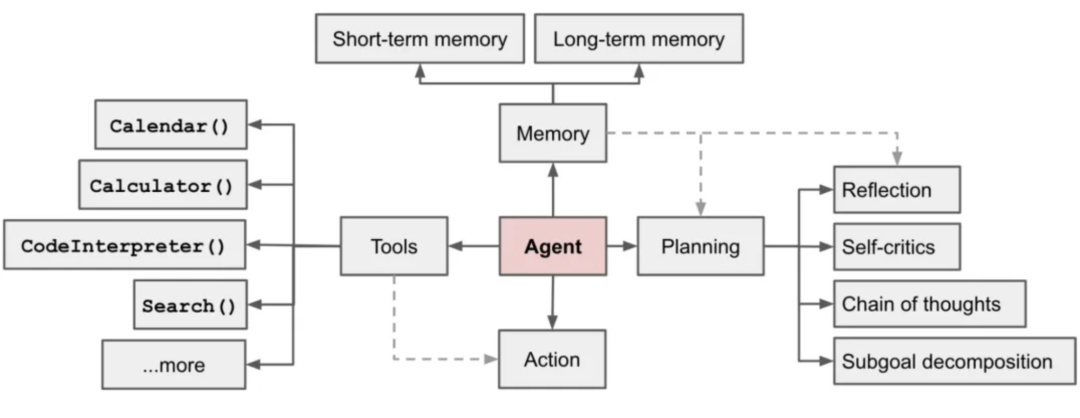
从上面的图可以看到,Agent作为调度器,可以思考planning、调用外部工具tools、行动action、记忆memory。其中tools是通过action执行的,中间的思考过程和工具执行结果都会存储在memory中,让大模型可以根据上下文去不断规划和反思。
从上面的介绍可以感受到Agent的重要性,相比于单个大模型,Agent可以自主地去处理事情(我的感受是Agent可以自主构建一套适用于当前场景的数据流,这是动态且在线完成的,相比于预设的流程更加灵活)。
关于工具调用的理解:
Agent最重要的能力之一是可以去触发工具调用,那为什么需要工具?原因很简单,因为大模型本身的知识来源于预训练的数据,而数据总会过时,比如用户询问“明天天气怎么样?”,大模型要么无法回答,要么胡乱回答。那如果模型有调用工具的能力(function calling),就可以生成标准格式的工具调用(比如json,包含tool name和param/argument),然后工具返回执行结果后(比如json),模型进行解析,然后将解析结果拼回上下文中。于是我们认为Agent就具有了回答这种训练数据分布外的问题的能力。
Function calling的能力怎么来?一种是训练的时候具备,另一种是prompt引导(但我觉得如果模型不大时,指令遵循的能力应该很有限)
什么是ReAct?
ReAct是一种非常典型Agent的推理模式(当然对我来说其实不是很典型,去业界才第一次接触到这个名词),也就是reasoning -> action (-> observation),这里observation其实也是action后工具的执行结果。假设我们把这个过程称作RAO,那这只是一轮的RAO,在ReAct推理中,可能会调用多轮RAO过程。我们称这个过程是multi-turn,或者mulit-turn tool call。
ReAct的核心能力:
- 自动决策与工具调用:Agent根据query分析是否需要调用工具。比如用户输入“请告诉我明天的天气怎么样?”时,Agent会自动触发调用工具
- Multi-turn的多轮迭代推理:也就是上面提到的RAO过程,(我目前了解到的)通常Agent会通过不同方式去决定是否结束推理
- 达到预设的轮数
- 大模型明确生成了类似answer的标签
- 某一轮没有调用任何工具
那么到这里,其实还是不清楚Agent为什么可以看到工具,怎么去调用工具,工具如何执行,以及返回结果怎么用。那就接着看后面的Agent实现部分。
用LangChain框架实现ReAct Agent
LangChain是非常常用的一个大模型框架,能快速上手Agent的构建,所以这里先用这个框架来实现一个Agent。
导入Python库:
# 导入必要的库
import json
import time
import os
from dotenv import load_dotenv
from langchain_core.tools import tool
from langchain.chat_models import init_chat_model
from langchain_core.prompts import ChatPromptTemplate
from langchain.agents import AgentExecutor, create_react_agent
from langchain import hub
最重点的部分,规范地定义工具!在ReAct Agent系统中,工具的定义必须非常规范,主要包含以下几个部分:
- 工具接口定义:也就是定义好函数的输入输出参数
- 工具描述:描述都要在函数开头的这段注释文字中,其中要包括工具的功能、输入参数、输出参数
- 工具内容:也就是函数体,正常按功能流程去实现就好了
值得注意的是,工具接口和描述都是可以被大模型看到的,这也就是为什么要定义地非常清晰才行。那如何被大模型看到呢?答案就是把可用的工具列表放在prompt中。
# 定义工具函数并提供详细的工具描述
# 1、商品工具
@tool
def query_goods(good_detail: str, goods_type: str=None, price_range: str = None) -> str:
"""根据商品名称以及价格范围商品数据库查找匹配的商品。
Args:
good_detail: 商品信息总参数,用来接受传参,真实的参数是后面的字段
goods_type: 商品类别,如"水果"、"手机"、"洗衣机"等
price_range: 可选,价格范围,如"1000-2000"
return:
查询到的商品列表
"""
goodss = [
{"goods_name": "苹果","goods_type": "水果","price": 1.00,"description": "苹果","id":"11111111"},
{"goods_name": "香蕉","goods_type": "水果","price": 0.50,"description": "香蕉","id":"22222222"},
{"goods_name": "小米15", "goods_type": "手机","price": 1500,"description": "小米手机","id":"33333333"},
{"goods_name": "iPhone 13","goods_type": "手机","price": 4099,"description": "苹果手机","id":"44444444"},
{"goods_name": "华为mate 70","goods_type": "手机","price": 7800,"description": "华为手机","id":"55555555"}
]
goodsDic = json.loads(good_detail)
goods_type = goodsDic["goods_type"]
new_goods = [goods for goods in goodss if goods["goods_type"] == goods_type]
if len(new_goods) == 0:
return f"\n\n抱歉,未找到相关的产品:{goods_type}\n\n"
if "price_range" in goodsDic:
try:
min_price, max_price = map(int, price_range.split("-"))
new_goods = [p for p in new_goods if min_price <= p["price"] <= max_price]
except:
pass
formatted_results = "\n".join([
f"{p['goods_name']} - ¥{p['price']}" for p in new_goods
])
return f"\n\n获取到以下的{goods_type}:\n{formatted_results}\n\n"
# 2、进行下单操作
@tool
def create_order(good_detail: str, goods_name: str = None, price: int= None, quantity:int=None) -> str:
"""创建订单,并返回订单编号。
Args:
good_detail: 商品信息,用来接受传参,正真参数是后面的字段
goods_name: 商品名称
price: 商品价格
quantity: 购买数量
return:
订单编号
"""
goodsDetail = json.loads(good_detail)
goods_name = goodsDetail["goods_name"]
price = goodsDetail["price"]
if "quantity" not in goodsDetail:
quantity = 1
else:
quantity = goodsDetail["quantity"]
# 当前时间的毫秒数 作为订单编号
order_num = int(time.time() * 1000)
# 模拟下单操作,返回订单编号
return f"\n\n订单创建成功,商品{goods_name}订单编号:{order_num},购买数量为:{quantity},单价:{price},订单总价:{price*quantity}\n\n"
# 3、进行支付
@tool
def order_pay(order_detail: str, order_num: int=None,order_price: int=None, payment_method: str = None) -> str:
"""进行支付,并返回支付结果。
Args:
order_detail: 订单信息,用来接受传参,正真参数是后面的字段
order_num: 订单编号
order_price: 订单价格
payment_method: 支付方式,如"支付宝"、"信微"、"银行卡"
return:
支付结果
"""
payDetail = json.loads(order_detail)
order_num = payDetail["order_num"]
order_price = payDetail["order_price"]
payment_method = payDetail["payment_method"]
# 模拟支付操作,返回支付结果
return f"\n\n订单{order_num}支付成功,支付金额为{order_price},支付方式:{payment_method}\n\n"
这一步构建工具列表、Agent实体以及引导Agent去调工具的prompt。
# 构建react prompt和agent
# 工具列表
tools = [
query_goods,
create_order,
order_pay
]
# react_prompt = hub.pull("hwchase17/react")
react_prompt = ChatPromptTemplate.from_template("""
Answer the following questions as best you can. You have access to the following tools:
{tools}
Use the following format:
Question: the input question you must answer
Thought: you should always think about what to do
Action: the action to take, should be one of [{tool_names}]
Action Input: the input to the action
Observation: the result of the action
... (this Thought/Action/Action Input/Observation can repeat N times)
Thought: I now know the final answer
Final Answer: the final answer to the original input question
Important: action Input must be a valid JSON object with the correct parameter names
Begin!
Question: {input}
Thought:{agent_scratchpad}
"""
)
# 初始化大模型
client = init_chat_model(
model="gpt-4.1-mini",
api_key='sk-6GnJrlYCoqIzu1xFWg8jEMmEwIq5C4txN2WlKQ2rBdcbGSin',
base_url="https://api.chatanywhere.tech/v1",
model_provider="openai",
)
print("="*10, "LLM Loaded Successfully", "="*10)
# 创建ReAct agent
agent = create_react_agent(
llm=client,
tools=tools,
prompt=react_prompt
)
# 创建agent执行器
agent_executor = AgentExecutor(
agent=agent,
tools=tools,
verbose=True, # 显示详细执行过程
max_iterations=5, # 最大工具调用次数
# early_stopping_method="generate", # 提前停止策略
handle_parsing_errors=True # 处理解析错误
)
最后则是给用户query到Agent,然后让Agent去解决问题(会需要调用定义的一个或多个工具)。下面是只需要调用一个工具的例子:
query = "我要买一个手机,我的预算是5000元,帮我推荐一款"
result = agent_executor.invoke({"input": query})
print(result)

下面是需要调用两个工具的例子:
query = "我要买一个手机,我的预算是5000元,帮我推荐一款,并进行下单支付,支付方式为微信"
result = agent_executor.invoke({"input": query})
print(result)
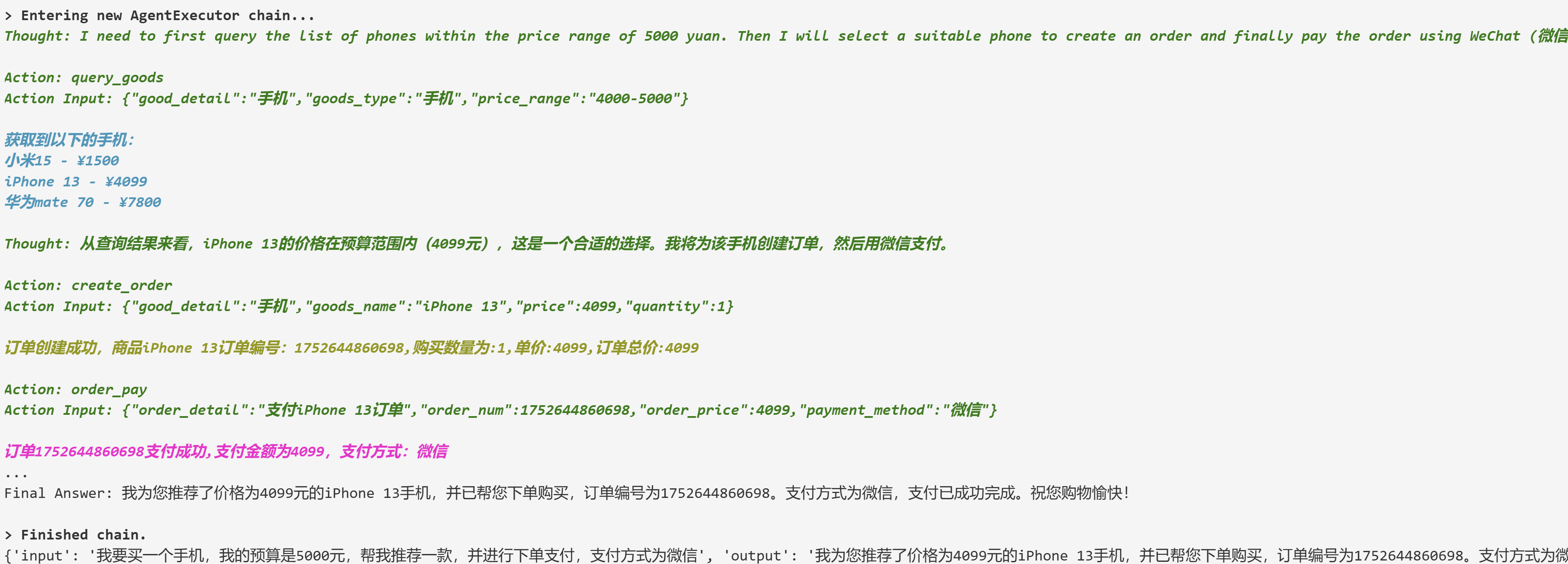
手写ReAct Agent
看了上面LangChain的实现后,基本能搞明白流程了,重点就是定义好工具函数,构造工具列表,构造好带工具列表的prompt,剩下的塞给LangChain就搞定了。
但是仔细一想,还有一些地方无法完全理解,比如multi-turn是如何迭代的?工具怎么就能整个塞进prompt了?如何决定迭代到什么时候停下来?
下面来看看核心的实现:
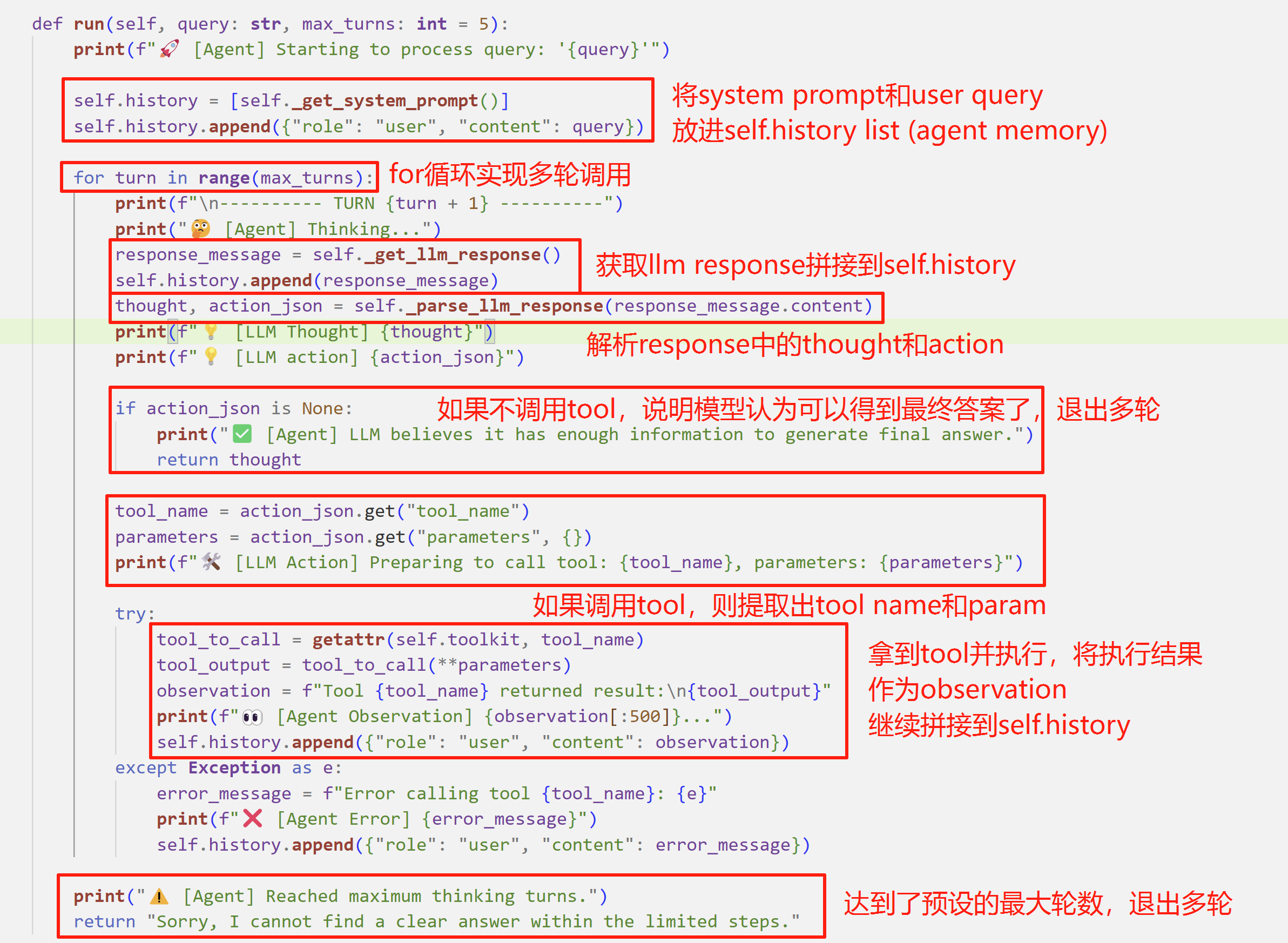
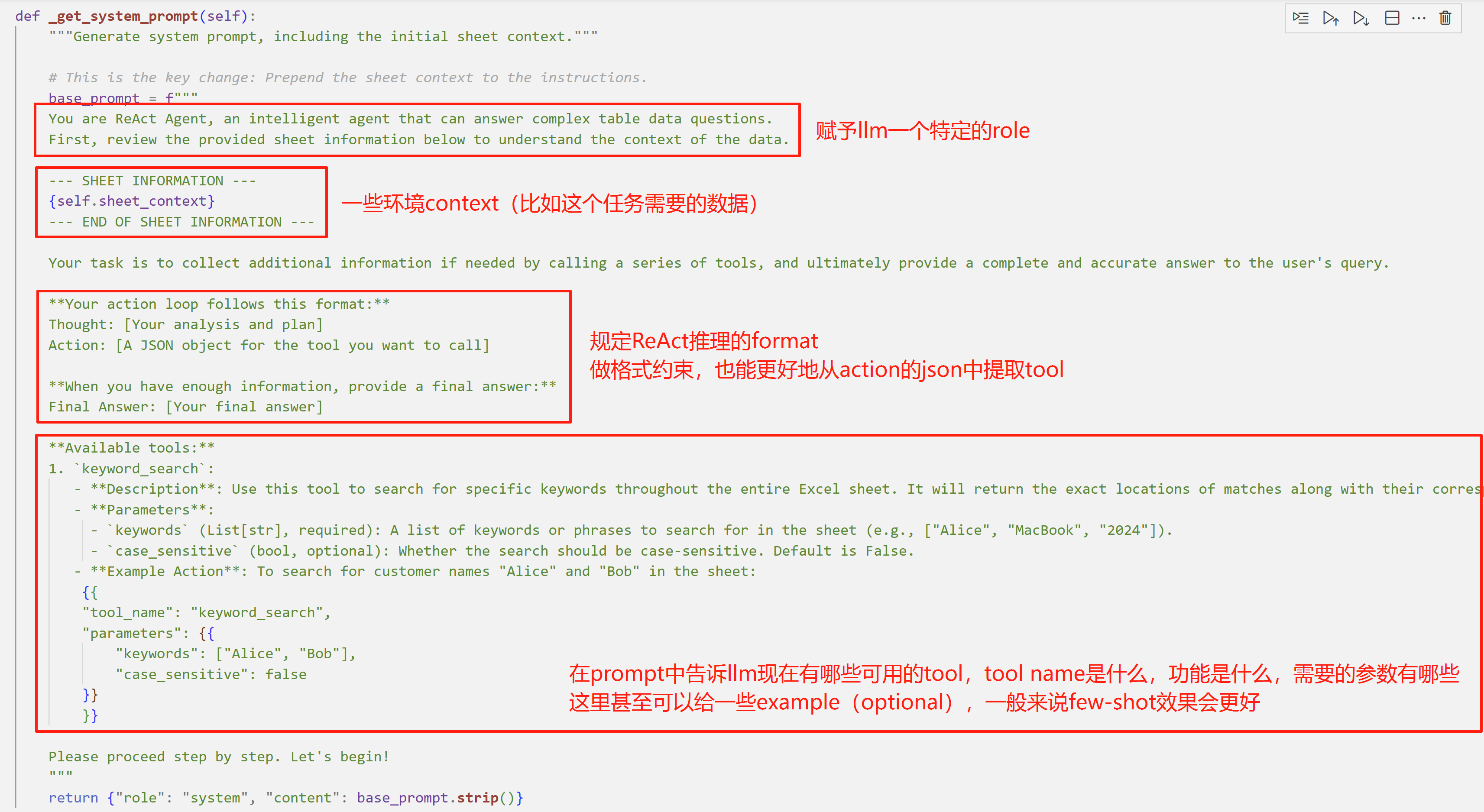

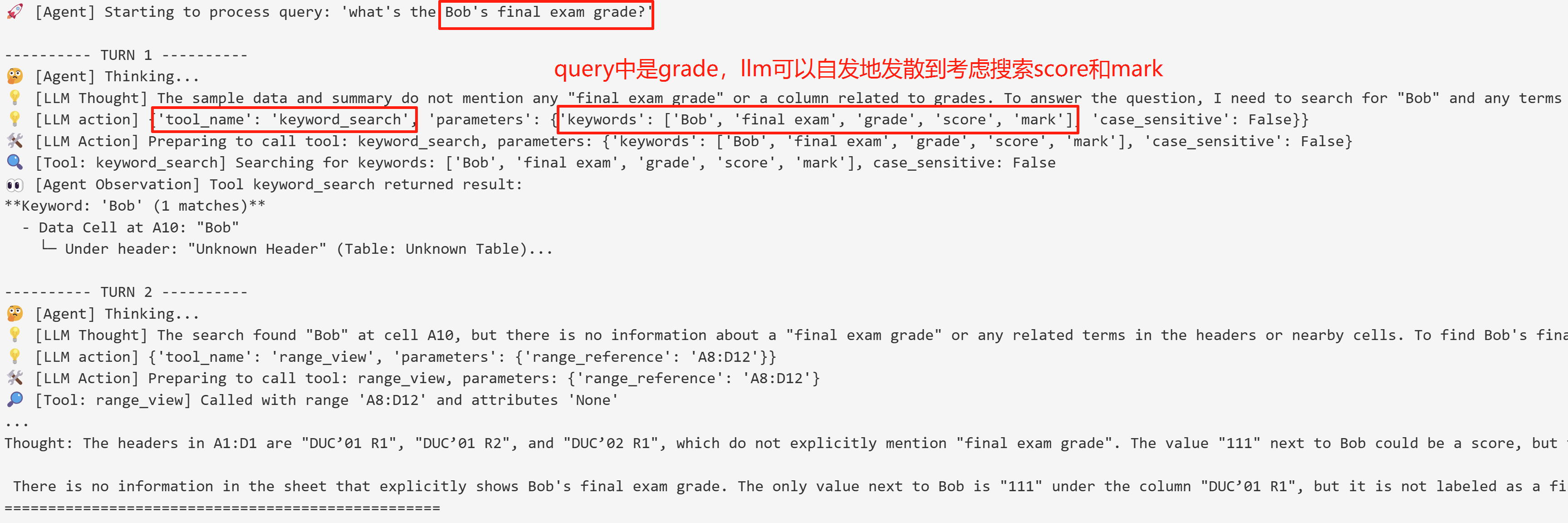
现在来依次回答这几个问题:
- 如何迭代?最简单的方式就是用for循环进行
- 工具如何塞进prompt?可以看到,其实prompt中只需要塞对工具的接口定义和描述(甚至可以给few-shot example),大模型真正去调用工具是通过
getattr(self.toolkit, tool_name)实现的 - 何时停止?要么是预设的循环次数达到了,要么是该轮不调用工具了,认为推理结束,要么是生成了
Final Answer关键词 - 其实我自己一直还有个 疑惑【关于生成格式和指令遵循】: 为什么大模型就能自己生成json格式的action呢,必须这样才能从中解析出tool name和param。可以看到prompt中已经其实给了action format(json格式),我目前的理解是,要么用是已经具有function calling能力的模型,比如GPT这些模型本身就具备这种调用工具的能力(已经训过了),要么就是模型本身足够强大,可以很好地遵循prompt,反之拿一个base model,肯定不会有这种效果。另外也可以看到,为什么能直接从response中去提
Final Answer后面的内容作为答案?万一模型的没生成Final Answer怎么办?其实在prompt中已经告诉了模型要把答案放在Final Answer后面,GPT这样的强大模型可以很好的遵循,而同样地,如果拿一个base model,也不会有这种效果。
总结一句就是,要实现Agent调用模型,必须生成规范的action(json格式的tool name+param),要满足这一点,要么大模型本身具有function calling能力,要么大模型本身很强大,可以去follow prompt里的要求和example。不管怎样,应该给few-shot example都是有帮助的。
还在初学积累阶段,如有错误,欢迎随时指正!谢谢大家